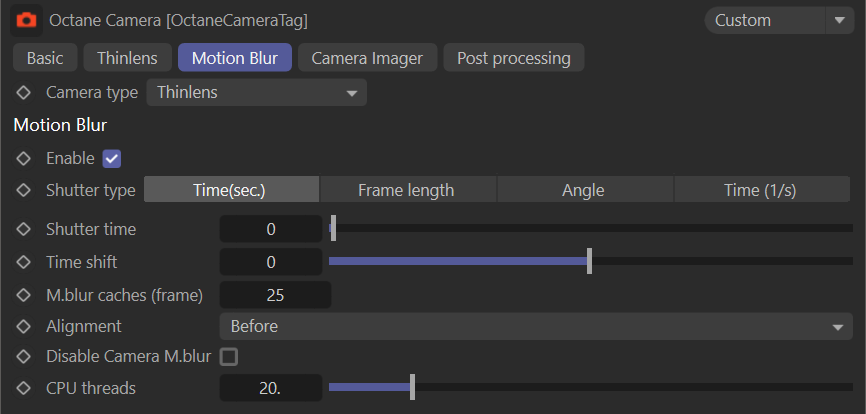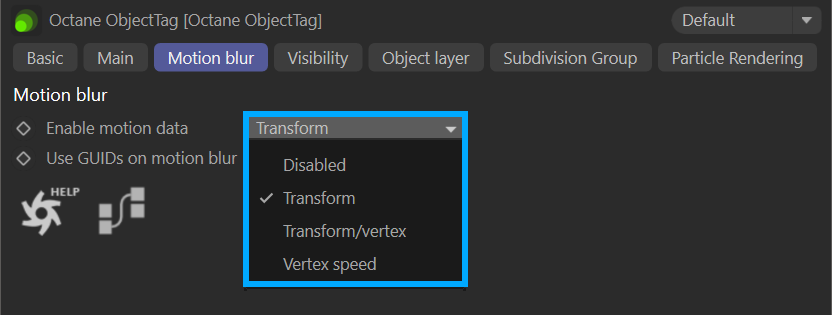Motion Blur
Motion blur in OctaneRender® is both fast and photo-realistic, as Octane correctly mimics the way that light is captured through a lens and shutter system. To get an accurate blur, adjust the shutter value relative to the frames per second value of your scene. It is also possible to mess with reality and get a "slit-scan" effect, alá "2001: A Space Odyssey" by using longer shutter duration times.
Octane has two different motion blur options: Camera and Object Motion blur. You will see the camera motion blur when the camera is moving. Object motion blur is used when the object is animated. You can control the camera motion blur from the Octane Camera Tag and the Object motion blur from the Octane Object Tag. Detailed explanations for both will be found in this section.
|
IMPORTANT NOTE Motion blur requires use of the Octane Object tag for all objects or object parents in a hierarchy. It may be tempting to disable the motion blur option in the Octane Object tag, or to omit an Octane Object tag from a hierarchy. If motion blur is enabled, the tags are required. Omitted tags or disabled motion blur can result in odd blur artefacts; in some cases, objects that are intended to not have blur will be incorrectly motion blurred. |
A common example of this involves locking an object to camera, so that the motion of the object relative to the camera is effectively zero. Without Octane Object tags on all the appropriate objects or object hierarchies, the object intended to appear locked to the camera will instead exhibit odd streaks. This is due to the fact that, with motion blur disabled or no Octane Object tag referenced, this object will be completely omitted from the motion calculation, resulting in an ambiguity. This is not a bug, but just how the system works. When in doubt, apply the tag and enable the blur.
Camera Motion Blur
Camera motion blur is the type of motion blur recorded when the camera in the scene is in motion. It is processed separately from object motion and can be disabled for special cases. Octane will create motion blur to match that of a physical camera and lens, which results from a combination of shutter speed, shutter angle and exposure time. The shutters on photographic and higher end motion cameras are either physically mechanical or "global," meaning that they can capture a complete frame in the same instant, while many (typically less expensive) digital cameras use an electronic shutter (rolling shutter), which can skew elements in a frame that would otherwise be vertical. A simple example of a shutter is a round disc with a slot removed from a portion of it. This open portion allows light to hit the film or sensor and expose the image. This process creates a recognizable effect of how objects in motion are recorded in the image.
|
|
camera imager — motion blur tab
|
About Shutter Speeds
The definition of "Shutter Speed": "In photography, shutter speed or exposure time is the length of time when the film or digital sensor inside the camera is exposed to light, also when a camera's shutter is open when taking a photograph. The amount of light that reaches the film or image sensor is proportional to the exposure time" (Source: Wikipedia).
Shutter speed determines the amount of time the shutter is open, thus exposing light to the film or sensor, which captures the image. The quality of moving images is dependent on shutter speed. The shutter speed can also determine the sharpness of the image which is also affects the amount of light reaching the camera sensor. If shutter speed is slow, a blurred image occurs.
Shutter speed values are expressed in proportions such as 16, 8, 4, 1, 1/4, 1/8, 1/16. As the number increases, your exposure increases. As the number decreases, you will have shorter exposure (like 1/15 or 1/500 of a second). "1/500" means the shutter opens and closes 500 times in a second.
For a good explanation of shutters, see this video.
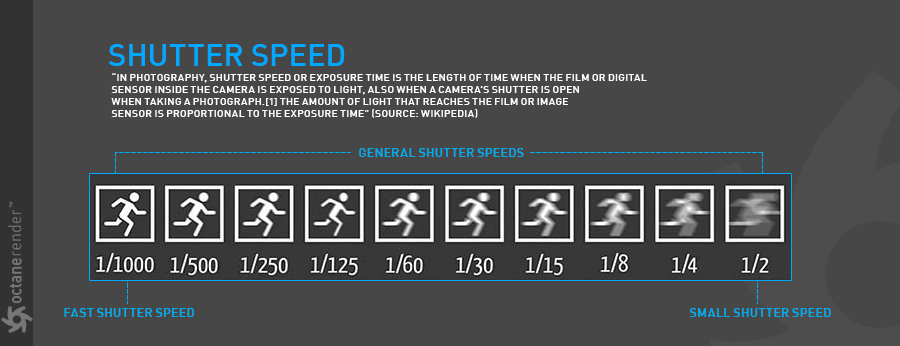
Motion Blur Settings
Enable
Used to turn Motion Blur on and off.
Shutter Type (sec.)
There are four options for Shutter Type:
- Time (Sec) — Adjusts the amount of motion blur amount in the rendered frame using frames per second. To enter the real-world shutter values, determine the desired shutter speed with this calculation, as follows: for 30 frames per second, divide 1 into 30; the result is 1/30 = 0.03, and this is the value to enter into the Shutter field, assuming a 360° shutter. For 24 frames per second, do the same math, and the result is 0.04. Divide that by two for a 180° shutter value, which is 0.02.
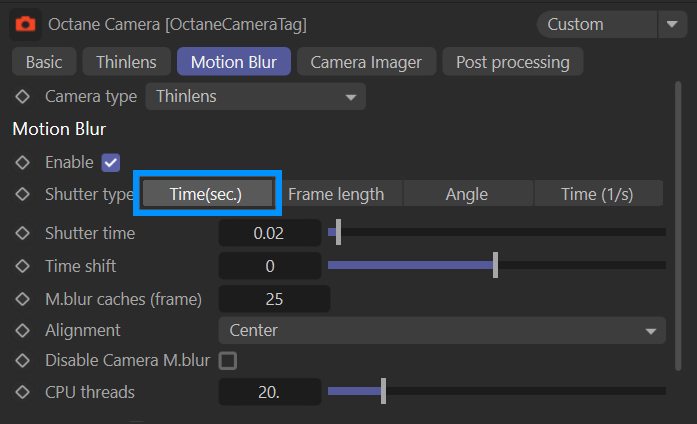
- Frame Length — Determines the amount of motion blur using the value shown in the Shutter Time attribute, which defaults to 50% (180° shutter) when Frame Length is enabled — this option is independent of the frames per second setting. Set the shutter time to 100% (360° shutter) for longer motion blur streaks.
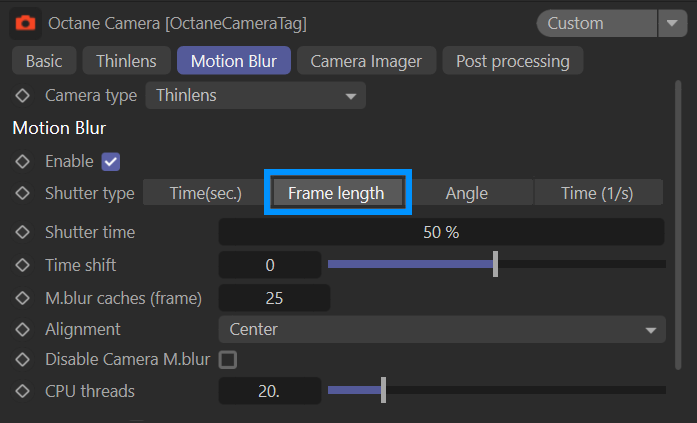
- Angle — Adjusts the amount of motion blur based on the shutter angle, which defaults to 180° when Angle is enabled. Angle is not dependent on the frames per second setting. Angle is of a rotational shutter found in motion picture cameras, which were typically set to 170-180°, with 360° being full frame. If the scene is set to 25fps, a 360° angle would mean 0.04 second shutter time per frame (longer blur), and 180° would be 0.02 seconds per frame (typical motion blur length).
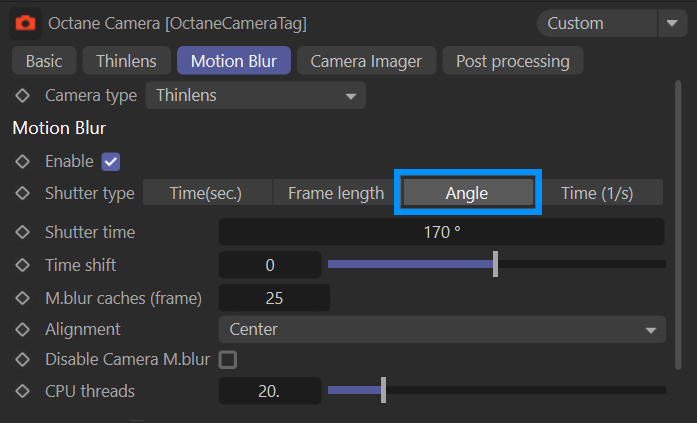
- Time (1/s) — This value sets the amount of motion blur based on the 1/s is a shutter like setting as seen in DSLRs and other cameras. Setting the Shutter time slider to 50 for example equates to 1/50, or 0.02 seconds in the Time (Sec) option.
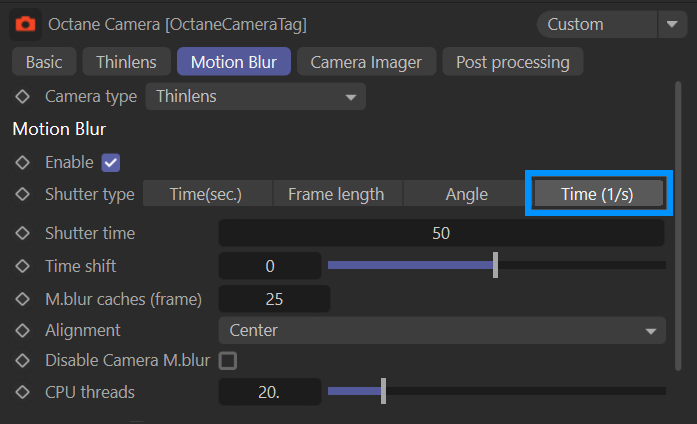
For a cinematic look, try 50% in Frame Length mode or 180° in Angle Mode, FPS*2 in Time (1/s) mode and 1/FPS*2 in Time(sec.) mode. Frame length and angle have the advantages that they are not dependent on the fps so if you set them up once the way you want, the motion blur length is the same even if you change the FPS.
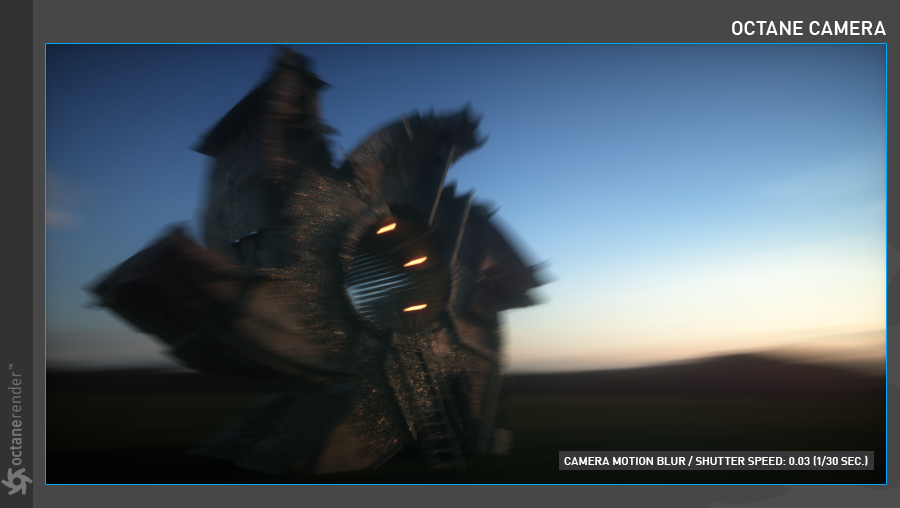
Time Shift (Sec.)
Used to shift the calculation frame of the motion blur.
M.Blur Caches (Frames)
This feature determines how many frames will be cached when moving back and forth in Live Viewer. Live Viewer only knows the data in existing frames. You can store the motion data in Live Viewer by entering the number of frames to be cached in this field.
Shutter Alignment
Shutter alignment has three options: Before, Centered, After. In general, it specifies how the motion blur effect is calculated relative to the previous or next frames. For example, if there is a motion blur of 10 frames and you are at 20th frame; Before: Produces blur according to frames between 10-20, Center 15-25 and After 20-30.
Disable Camera M.Blur
You can activate this feature if you want to see only the motion blur of the objects, but not the motion blur effect of the camera.
Object Motion Blur
This option is used to apply motion blur only to objects in motion with Octane Object tags with the Motion Blur option enabled. Objects without an Octane Object tag with motion blur enabled will not be motion blurred properly and may appear incorrect.
|
|
octane object tag — motion data selection
|
Enable Motion Data
There are four options: Disabled, Transform, Transform / Vertex, and Vertex Speed:
Disabled
Disables motion blur for the object.
Transform
Enables motion blur to the Position, Scale and Rotation transformations of the object.
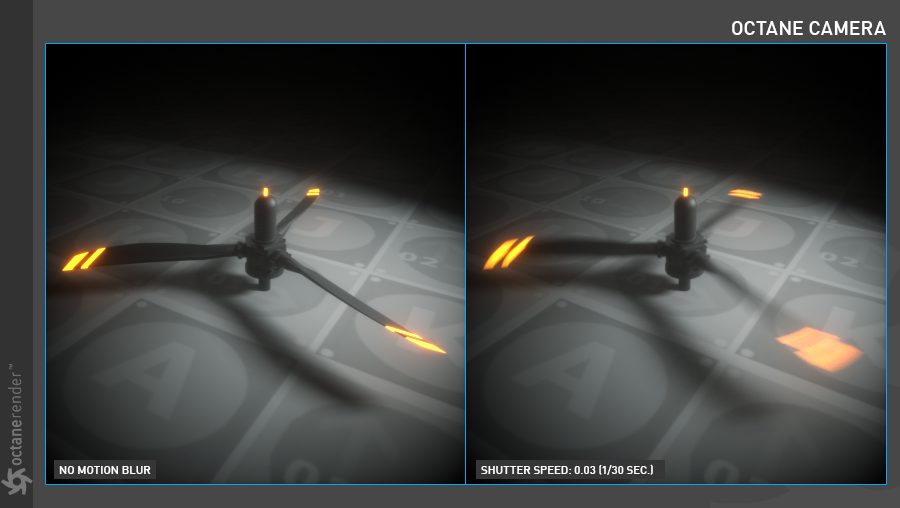
Transform/Vertex
Motion blur is calculated for both the transform and vertex movements of the object (such as character rig deformations, hair, etc.)
Vertex Speed
This option calculates the correct motion blur for volumetric and fluid flow simulations. Three separate vertex maps (one for each X, Y and Z axis) are required.
Use GUIDs on Motion Blur
This option can help with motion blur in some cases, but not when objects are enabled or disabled in a scene (such as when particles are created or removed during a shot). If you experience issues with wrong or missing motion blur, make sure that this option is disabled. Defaults to DISABLED.
Motion Blur with Render Instances
When using a Render Instance, it is best to create the instance from the original, and animated the Instance only; place the original (with no animation) in a null object and move somewhere off-screen for the duration of the shot. To render properly, the object and parent null MUST be enabled, otherwise the Render Instance will not be visible at render time.
When using Render Instances in a Cloner, follow the same procedure, but supply the Cloner with the Render Instance instead of the original geometry. The Cloner will need to be set to Instance instead of Render Instance, as the supplied Render Instance is already an instance.

